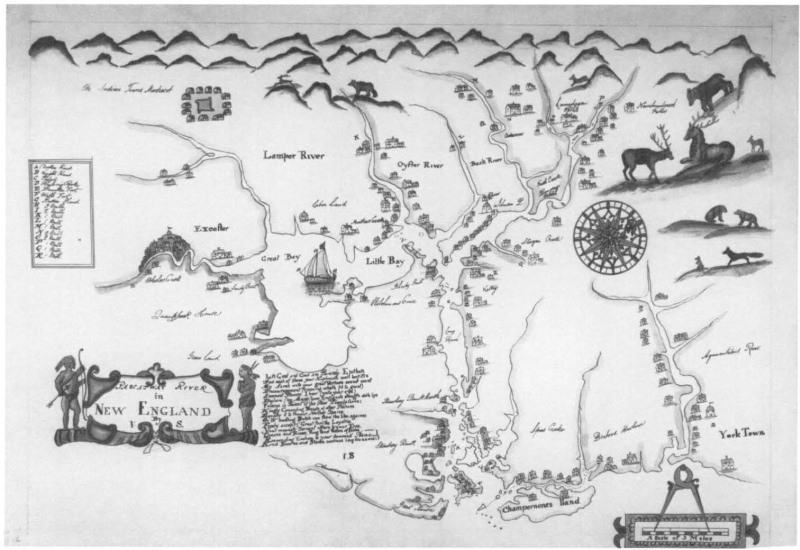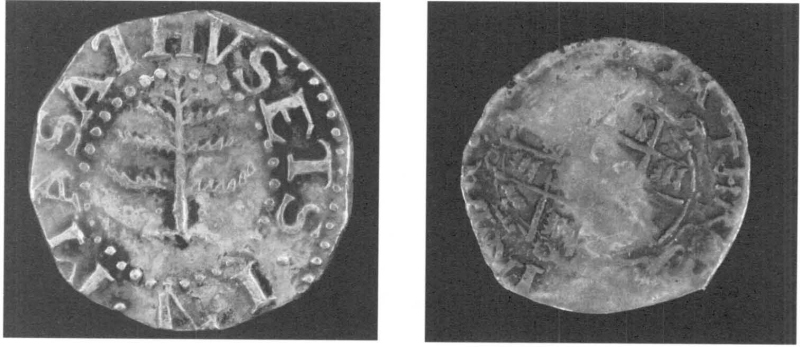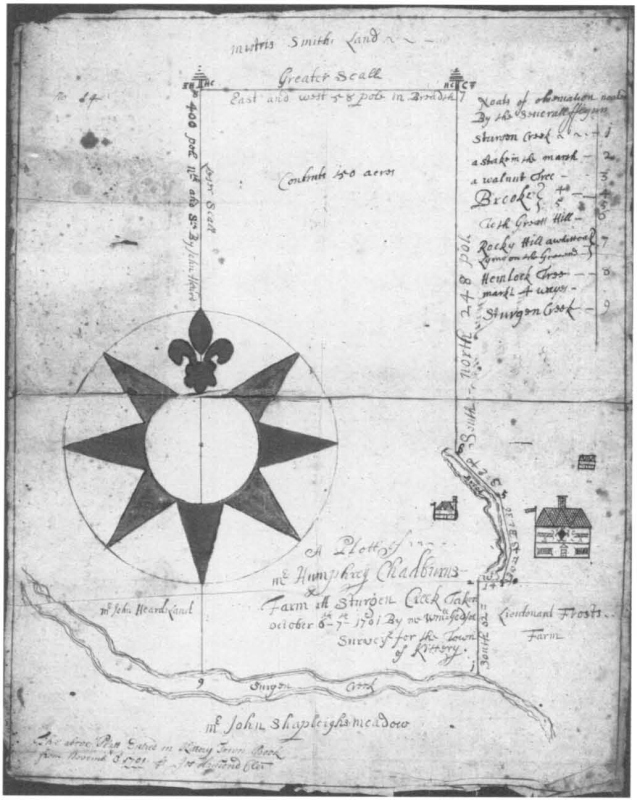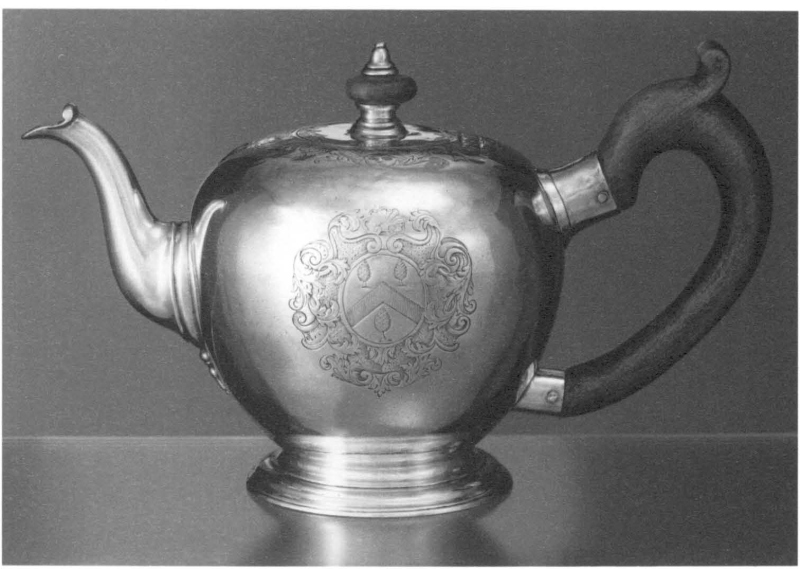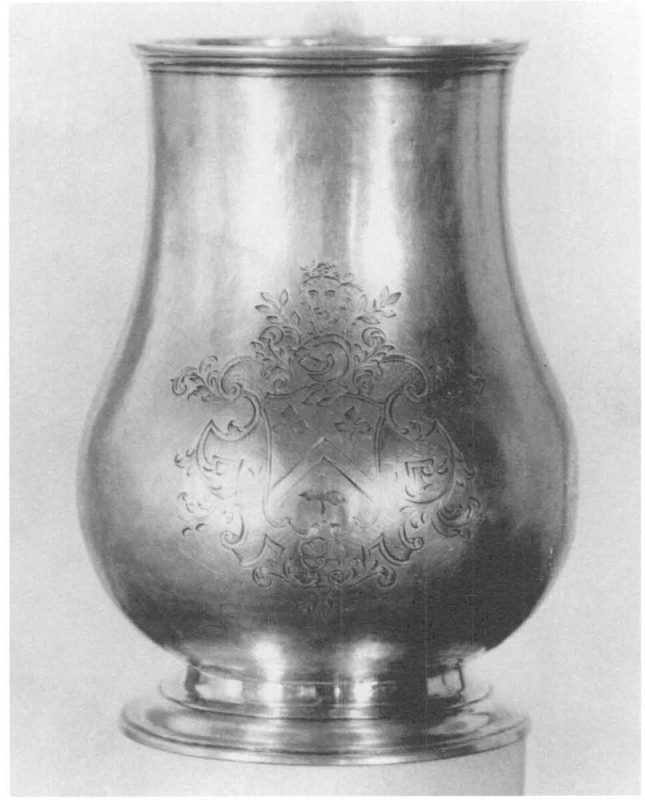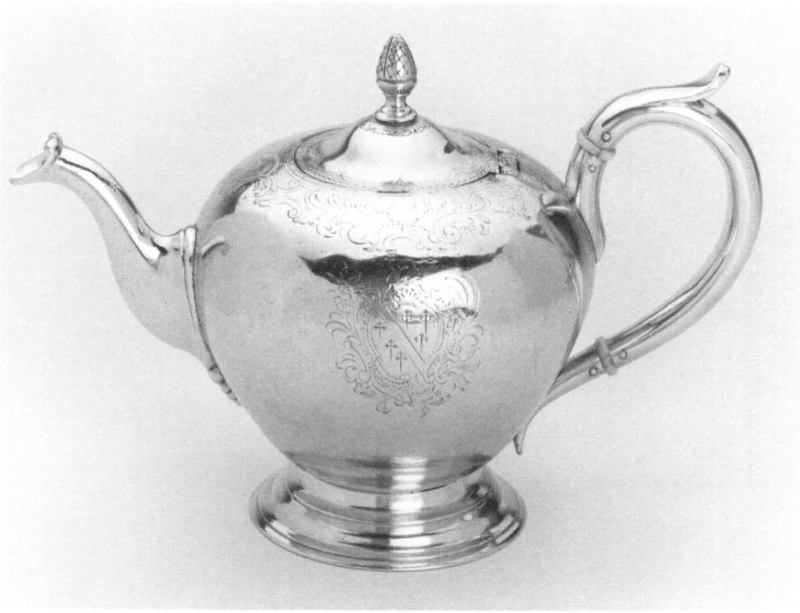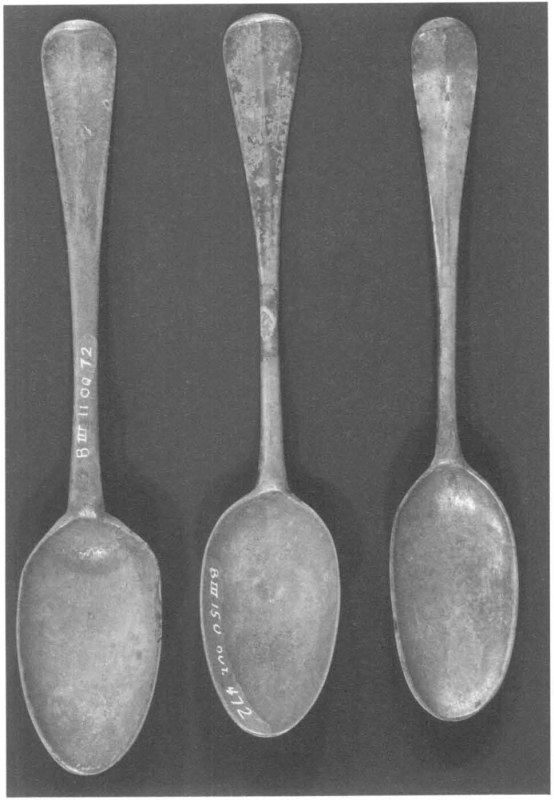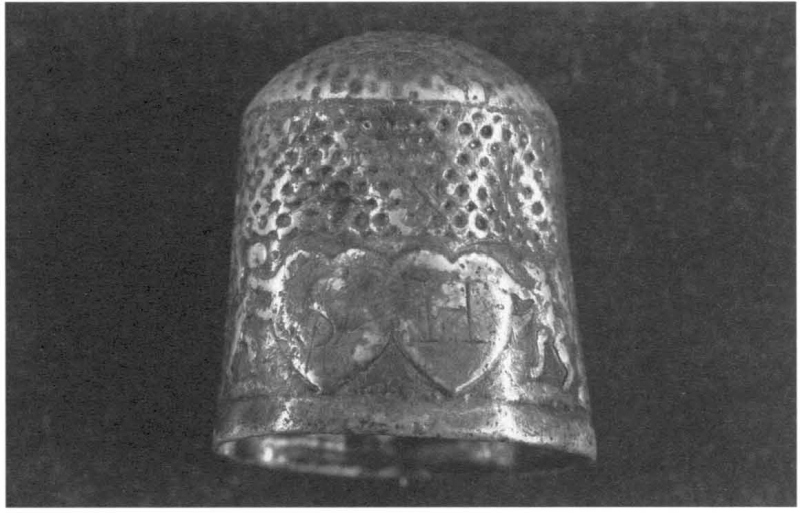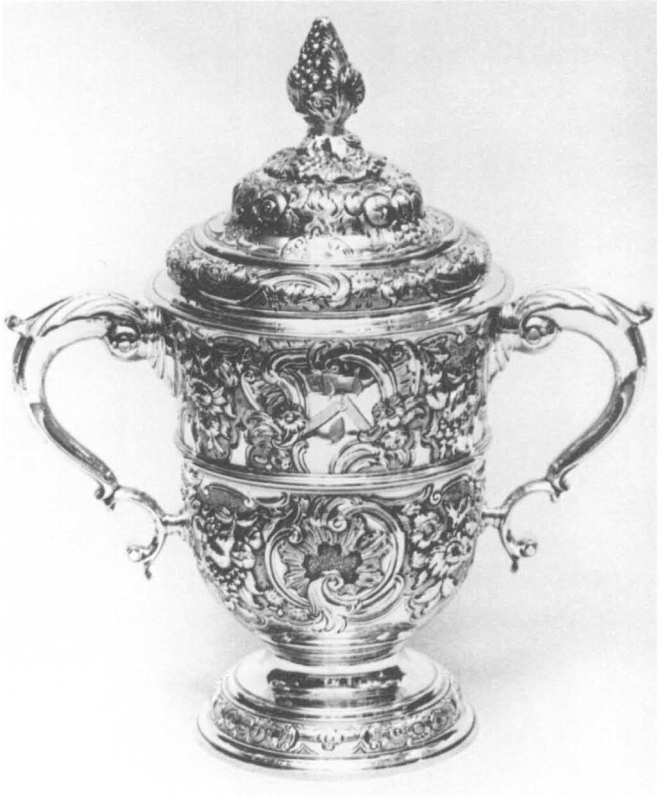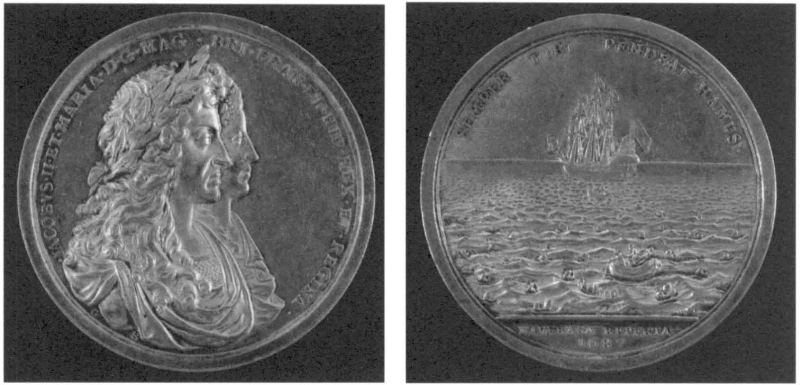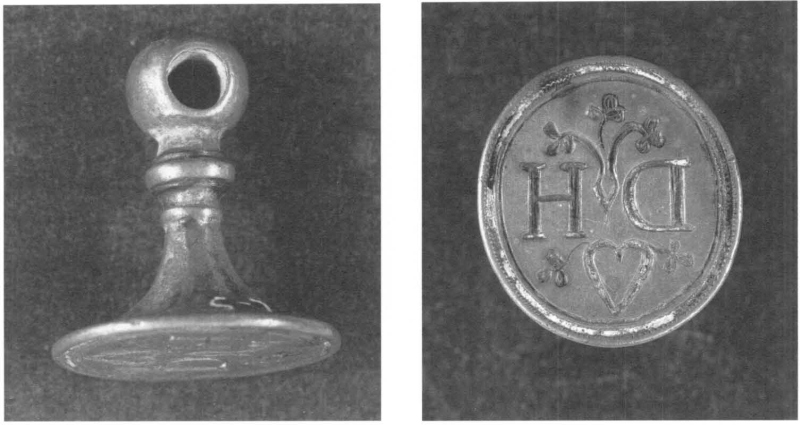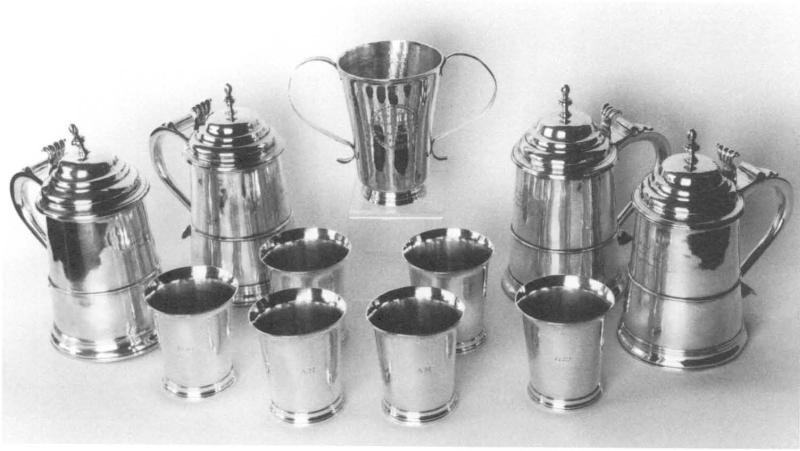Glistening Reflections of Stability: The Roles of Silver in Early Maine
Edwin A. Churchill
In 1760, two Massachusetts silversmiths, Paul Little of Newbury and John Butler of Boston, made their way northeast to Falmouth (present-day Portland) in the province of Maine.1 The first silversmiths to settle in this region, they signaled the beginning of a new era. Previously, the area (fig. 1) had been an unpromising site for such urban-oriented, specialized artisans. Throughout the 1600s, Maine towns were tenuous entities stretching along the coast from Kittery to Pemaquid as non-nucleated ribbon settlements of perhaps four to five hundred people each.2 A society made up largely of farmers, woodsmen, a few basic artisans, and even fewer merchants, it did not provide an economic base sufficient to support workers of fine metals.3
Despite the absence of silversmiths, silver was present in a fair number of early Maine homes. Still, evidence suggests that even the best collections were relatively modest; in fact, only a few estate inventories list silver items individually. The earliest items, a silver cup worth £1 10s. and money valued at £6.11.3, appeared in the 1648 estate of Joseph Cross of Wells.4 Kittery merchant Robert Cutts’s 1674 listing included a porringer, a dram cup, a small beaker and nine spoons, whole and broken, valued at £3. The 1681 inventory of Major Brian Pendleton, from Saco and then Portsmouth, included a tankard and three cups, valued at £6.1s.5 Several inventories included larger but unenumerated silver holdings. Records reveal that in 1663 Kittery entrepreneur Nicholas Frost had £14.13.7 worth of plate, and in 1689 Edward Rishworth of York left behind silver valued at £12.6 The contrast with a quarter century later is striking. Kitten merchant and public official Elihu Gunnison left an estate of 308 ounces of silver including, among other items, one large and one quart tankard, a punch bowl, two chafing dishes, a large and a small salt, a two-handled cup, a teapot, two candlesticks with snuffer and stand, six porringers, one small and one pint cann, a salver, and three pepper boxes.7
Despite the marked humbleness of seventeenth-century holdings, the region underwent a period of significant growth and development that peaked in the early 1670s; had it continued, silversmiths and other specialized craftsmen would have arrived in the area long before Butler and Smith. Such possibilities dissolved in 1675 with the outbreak of warfare between English settlers and local Native Americans, who were soon joined by the French allies. Fighting raged for another half century, and during the most vicious period of conflict, English settlers remained only in the most southerly communities of Kittery, York, and Wells.8 Not until the late 1720s had warfare diminished to the point that recovery and expansion became possible. Again, the region developed rapidly—a growth evident by midcentury in both the quantity and variety of silver and gold items held by inhabitants. A new sophistication also emerged, embodied in such specialty forms as salvers and spout cups and in the increasingly frequent appearance of jewelry and small gold objects. When Quebec fell to the English in 1759, the Maine frontier became safe from further hostilities.
Fig. 1. Unidentified artist “I.S.,” Pascatway River in New England, ca. 1660. Ink. on paper; h. 19 in., w. 29 in. Maine State Archives, Baxter Rare Map Collection.
Silver in Maine, like gold, both symbolized and influenced societal patterns that matched, in many ways, those suggested by English scholar Grahame Clark, who observed that “precious substances contributed most effectively to the functioning of traditional societies by defining roles in the functioning of the hierarchy of authority.”9 In the region, as probably was true in general, the significance of these objects operated in three broad fields. At the most basic level, always present, was the economic worth and solvency of the metal per se. Building on this foundation, the families that could afford silver tended to use it for different forms of self-presentation: in the community at large, sometimes even internationally, to display and validate their status and power, and in the smaller community of their own families and closer social circles to cement family ties and solidify societal patterns. Of course, these factors overlapped in the seventeenth and eighteenth centuries. Individual pieces often served in two or even all three categories, but here I will discuss them within the contexts that delineate those functions as clearly as possible.
A body of extant items, ranging from major pieces both personal and ecclesiastical to smaller personal objects, suggests a substantial presence of silver in the homes of the wealthier and some of the middling inhabitants of early Maine. The broadest patterns of ownership can be reconstructed from the evidence of these pieces and the archival records that testify to the many pieces that no longer exist. A search through all extant inventories covering the periods 1630–1710, 1725–1735, and 1750–1760 revealed 160 estates that listed silver and gold items.10 The evidence demonstrates that individual holdings varied dramatically. While most examples, especially larger pieces such as tankards, canns, and porringers, belonged in affluent homes, a fair number of objects were owned by individuals of modest means.11 For example, the 1752 estate of aforementioned Kittery merchant Elihu Gunnison, worth £1,806.3.10, contained more than three hundred ounces of plate—including tankards, porringers, cups, a cann, and a chafing dish.12 Conversely, the less affluent 1754 estate (£345.19.4) of York inhabitant Andrew Grover listed but one silver entry, “silver Bows of Spectacles.”13 Spoons, with over three hundred listed examples, appeared in inventories more frequently than any other object. Rings took a distant second—sixty-nine instances—and clothing-related items such as buckles, buttons, and jewelry followed closely behind.
Early Maine probate inventories, like nearly all colonial records, unequivocally tied the value of silver holdings to the weight of the metal. Objects frequently appear in these lists with their value designated by total weight, value per ounce, and total price. In the fairly typical 1752 inventory for Elihu Gunnison, for example, one finds “a large Silver Tankard wt 48 oz; & a punch Bowl wt 28 1/2 oz; one large Salt wt 13 oz,” all followed by a tally at the end for “308 ounce a 6/8 pr ounce . . . £102.13.04.”14 The final balancing of the 1756 estate of Thomas Perkins included the sale of a half dozen large silver spoons for £4.6s, the same value given them in the original appraisals.15 The same estate contained tankards, porringers, and canns that were not sold but probably passed on to heirs.
Silver wares may have been viewed as a buffer in case of economic need, since any piece could, if necessary, be converted into cash or otherwise used against outstanding obligations.16 Owners, however, rarely embraced this option—and certainly not with enthusiasm. When one acquired a new object, the price included not only the value of the metal but about an equal cost for the workmanship. Conversely, when an item went up for sale, potential buyers usually preferred not to pay much over the cost of the metal.17
Fig. 2a, b. New England sixpence and Spanish colonial two real, 1600s. Silver; diam. (sixpence) ¾ in., diam. (two real) ½ in. Maine Bureau of Parks and Lands.
The high commodity value of the metal itself, however, becomes apparent when one examines the economic role accorded fine metal coins.18 Gold and silver coinage, while more easily used for exchange than fine metal objects, still carried a commodity value that far exceeded its role as a medium of exchange; simply put, coins were worth substantially more than their face value. This meant that a ten shilling coin would be valued at a good deal more than ten shillings worth of cloth, gunpowder, or any other commodity. In a 1666 legal dispute, for example, the court decided that along with “merch. Goods” the defendant was to pay eleven shillings “in money . . . to [be] rated at money price . . . [which] comes to £1,7s,10d” or 27s.10d—a 253 percent increase.19
As with other fine metal objects, coins appeared more frequently in the holdings of Maine’s wealthier inhabitants, where they clearly functioned as an asset in and of themselves. Their possession generally arose from and indicated an involvement in the world of colonial commerce, where coinage constituted a major commodity in regional and international trade. Because British mercantile policy discouraged the export of gold and silver, colonial merchants sought out other sources of specie, consequently creating a significant cache of non-British coins in colonial coffers (fig. 2), a fact reflected in early probate records.20 While many documents simply listed “money” or “coins,” followed by a value, others noted gold French guineas, Spanish doubloons, and Portuguese moidores along with higher value silver coins such as Spanish pieces of eight, and Dutch “rix” or “lion” dollars.21 What is clear is the desire by Maine inhabitants, often “of the better sort,” to transfer these assets to chosen heirs, thereby bolstering the recipient’s economic worth.
◑
Despite its fundamental value, silver and gold coinage never carried the status of fine metal presentation and personal items. Objects fashioned from gold and silver, unlike coinage, suggested an individual’s distinct stature in his community via the basic fact of a smith’s custom workmanship, including such details as engraved initials, inscriptions, and emblems. The value placed on custom pieces suggests the most basic societal aspirations of New England colonials. In their hearts, early Maine settlers were displaced Englishmen and women. They wanted to reconstruct England in the New World, legally, politically, and socially. Every community had a number of outstanding families (by their standards), who sought, as did their Old Country models, income, prestige, power, and the pleasant way of life.22
Since Maine’s more prosperous inhabitants came largely from England’s West Country and Midlands, among other rural communities, they were probably most familiar with the luxuries of the country seat rather than those of the urban home.23 That model served the colonials well, given their position on a wilderness frontier. Substantial tracts of land, and often the timber that grew on it, served as a key facet of their income and provided the stage for their demonstration of status and power.24 Mimicking English gentry, Maine’s leading citizens built large homes (fig. 3) and adorned them with the finest furnishings.25 The details of Major Nicholas Shapleigh’s Kittery estate depict just such a home. The house “was a full two-story structure often rooms plus cellar and garret.”26 In his “Inner rowme,” Shapleigh had a bedstead with curtains, valances, and other accessories, and an “ovell Table & Carpet . . . one chest of drawers & Cubbard Cloath . . . 6 Turkey chayres . . . [&] 4 leather Chares” along with other wares, and in “the Major’s Lodging Rowme” were “one standing bed & a tumble bed with furniture, a little table & a Carpet . . . a Court Cupboard . . . a iron bound Case . . . [&] one Spanish Chest.”27
Shapleigh’s holdings also included “70 ounches of plate,” probably displayed on the chest of drawers in the inner room or on the court cupboard in the Major’s lodging room.28 This kind of display, as much as the furniture, was an integral part of the use of material culture to demonstrate one’s societal stature. The silver holdings of Sir William Pepperrell, Jr., of South Berwick were probably the most dramatic of those held by any Maine family. The son of prosperous merchant Colonel William Pepperrell, Sir William had an illustrious public service career, capped by his role as the colonial leader in New England’s 1745 capture of Louisbourg. For this, he was given a barony and received an extraordinary silver presentation service (discussed below).29 Prior to that time, Sir William had acquired other silver objects, such as candlesticks and flatware.30 Some of the extant pieces exemplify the embodiment of station in silver design. For example, a teapot made by Jacob Hurd of Boston, ca. 1735–45 (fig. 4), has a stylish globular body with splayed foot, curved spout, and wooden scroll handle.31 Pepperrell also owned a mustard caster by Andrew Tyler of Boston, ca. 1723–30, with a baluster body, high domed cover, and simulated piercing pattern. The initials “P/WM” engraved on it refer to William and his wife, Mary (Hirst) Pepperrell.32
Fig. 3. William Godsoe (1650–ca.1730), Mr. Humphrey Chadbourne Farm [in Kittery, Maine] . . . , October 6th–7th–1710. Ink on paper; h. 10 in., w. 12 in. Maine State Archives, Early Court Documents.
When the rapidly growing community of Falmouth, Maine, began attracting new political and commercial figures during the second quarter of the eighteenth century, the newcomers also used silver to declare their status. Samuel Moody (d. 1729) and Edmund Mountford (d. 1739), for example, both left large holdings of silver. Moody, raised in Portsmouth and a graduate of Harvard College, spent a period in the ministry before taking up a career in the military. After serving as commander of Casco Fort (near Falmouth) from 1707 to 1713, he settled in Falmouth and took up an active life as a public official. When he died in 1729 he left an estate of ninety-one-and-a-half ounces of silver.33 Mountford, the son of a successful Boston merchant, purchased a substantial property in Falmouth in 1726 where he later served in a number of offices, including selectman, deputy sheriff, and town agent. Mountford’s very “handsome cupboard of plate” comprised two tankards, four porringers, two cups, a pepper box, over a dozen spoons, a pair of tea tongs, gold rings, buttons, necklaces, and miscellaneous other items.34 Through these acquisitions, “newcomers” such as Moody and Mountford allied themselves with the well-established families, such as the Pepperrells.35
Fig. 4. Jacob Hurd (1702/03–1758), teapot, Boston, Massachusetts, 1735–45. Silver, h. 5⅛ in. Yale University Art Gallery, Mabel Brady Garvan Collection (1930.1350).
The role or roles that a collection or sometimes just a single piece of silver played in its owner’s life actually covered a wide range, from the modest expressions of fairly simple homes to the “handsome cupboard of plate”36 displayed on chests, cupboards, and shelves in halls, parlors, or bedrooms in the great houses.37 Some objects, such as buttons or buckles worn on the clothes or small objects used mostly within the home, functioned in relatively subtle ways. More prominent objects could be central to social occasions and public perceptions, from a tea set used in the home to a silver-hilted sword worn at a man’s side. Several owners ornamented their pieces with family coats of arms in the conscious effort to establish themselves with the status of English gentry,38 as did the Frosts and Pepperrells of Kittery and the Howards of Fort Western (later Augusta) (fig. 5).39 Some pieces were actually designed and made specifically for presentation on special occasions, from the domestic rites of birth and marriage to public ceremonies honoring an individual’s participation in large historical events (fig. 6).
Fig. 5. Unknown maker, cann, ca. 1750–77. Silver; dimensions unknown. Present location unknown. Photo, courtesy Joseph Frost.
Among the general population, possessing several small pieces or a larger cache of silver objects must have provided a sense of personal satisfaction, even where ownership was only a distant echo of the resources of the elite. Small objects destined for little more than personal use played similar roles in middling as well as wealthy families. Not surprisingly, records indicate that the most substantial body of silver filled primarily personal and familial roles. Unlike large display pieces, the significance of these smaller objects revolved around their use, either personally or as part of relational activities. They frequently had particular personal significance to the owner, an importance reflected in engraved initials, names, and symbols, markings that many times signaled their societal roles as well. Unlike display items that might be upgraded with better pieces, these pieces were cherished for their strong personal ties.40
The most commonly owned pieces, according to the evidence, would have been the silver spoons. The phenomenon suggests a number of things, including a relatively widespread desire to own silver and the importance of fulfilling that desire in even the most domestic venue. While many silver spoons came as tea service sets—an acquisition that required some wealth—quite a number of homes kept only one or two silver spoons.41 In those instances where inventories listed “two spoons” or “a pair of spoons,” a husband and wife probably held the small treasures for their personal use.42 In those instances recording one spoon, the head of the house might have reserved it for his or her personal use. Quite often, inventories listing a small number of spoons included one or two small companion hollowware pieces, thereby evoking the image of an individual, a couple, or a small family group sitting down for a snack or meal with favorite personal items. The 1664 estate of John Mitchell of Kittery, for example, noted “Two silver spoones and two cups,” and his fellow townsman Thomas Spencer left behind “a silver cupp & spoon” in 1681. The practice still flourished over a half century later: Falmouth resident George Welch owned “1 Silver Spoon [&] . . . 1 Silver Bowl” (1754) and his neighbor Thomas Woodbery held “1 Silver Cup [&] . . . 2 spoons Ditto [silver]” (1758).43 Domestic intimacy rather than status dynamics seem the heart of such groupings.
Fig. 6. Nathaniel Hurd (1730–1778), teapot, Boston, Massachusetts, 1766. Silver, h. 5⅞ in. Courtesy, Winterthur Museum (1960.1045).
Fig. 7. Unknown makers, spoons, found at Pemaquid, Maine, ca.1740–70. Silver; various dimensions. Maine Bureau of Parks and Lands.
The combination of the two urges seems evident in the desire to declare personal possession of even the most simple pieces, such as a number of extant spoons that carry individuals’ initials. Three apparently unrelated silver spoons (fig. 7), found during the excavations of the various forts at Pemaquid, have the owners’ initials engraved on the backs of the handles—a pattern echoed in a number of pewter spoons recovered from the Defence, a colonial privateer sunk in Stockton Spring Bay in 1779.44 In both instances, the initials probably served to distinguish each man’s spoon in a military living situation; nonetheless, the practice also suggests a strong sense of personal ownership that would have had a parallel among civilians.
Other small items most easily categorized as “personal gear” may have filled a purpose similar to that served by silver spoons. Objects for personal adornment, including jewelry, and small articles for personal use were apparently more widely accessible and therefore suggest a broader class spectrum of ownership.45 The jewelry most likely belonged to women as did a small number of articles for personal use. These, interestingly, relate to women’s domestic roles. Silver bodkins—needle-shaped tools for pulling tape through hems—were listed in two probate inventories, as were two silver thimbles.46 One silver thimble was recovered from a Maine archaeological site (fig. 8).47 These were most likely small treasures to their owners, objects that were passed from generation to generation.
Fig. 8. Unknown maker, thimble, Pemaquid, Maine, ca. 1660–75. Silver; h. ¾ in. Maine Bureau of Parks and Lands.
Other small, portable articles belonged primarily to men. Some, such as tobacco and snuff boxes, added elegance to the use of a New World product—the owner would certainly have displayed his silver box when taking its contents. A gentleman could similarly show his silver watch as he checked the time, whether necessary or not. And what better way to express one’s status than with a silver-headed cane, several of which appeared among the accoutrements of eighteenth-century Maine’s well-to-do.48
Like small silver items, objects of personal adornment, such as clothing accessories or jewelry, combined the pleasure of enhanced appearance with a visual statement of status. Although such items eventually became accessible to the middling as well as the upper classes, such finery was initially the province of the elite. Seventeenth-century “sumptuary laws” legislated the distinction; in 1651, the Massachusetts Bay Court expressed its
Utter detestation & dislike that men or women of Meane condition, educations, & callinges should Take uppon them the garbe of gentlemen, by the Wearainge of gold or silver lace, or buttons, or Points at their knees, to walke in greate bootes; Or women of the same ranke to weare silke or tiffany hoodes or scarfes, which though allowable to persons of greater estates, or more liberall education. Yet we cannot but judge it intollerable in psons Of such like condition.
The court therefore ordered that
No person within this jurisdiction . . . whose visible estates, reall & psonall, shall not exceede the . . . value of two hundred pounds, shall weare any gold or silver lace, or gold or silver buttons, or any bone lace above two shillings p[er] yard, or silke hoodes or scarfes, uppon the penalty often shillinges for every such offence; & every such delinquent to be psented by the graund jury.49
Soon after, the Bay Colony usurped Maine, which then theoretically fell under the same restrictions. In fact, there is little evidence that the 1651 act or other sumptuary laws were ever enforced in early Massachusetts or Maine. Probate records suggest that there was no great need to repress overdressed inhabitants of the lesser sort in Maine—few could afford the cost of fancy dressing.
Nonetheless, small silver pieces fashioned for personal adornment were clearly popular with a relatively broad range of consumers. Of all clothing accessories, buckles were apparently the most popular, judging from the frequency with which they turn up in inventories. Silver buckles appear in fifty-one different inventories and include eighteen instances of shoe buckles, ten of knee buckles, and four of neck buckles.50 The inventories also mention two gold buckles—one “a golden Buckle for a Girdle” and the second a “gold Brest Buckle.”51 Silver-plated buckles appear nowhere in the records, but two were excavated at Pemaquid, one a seventeenth-century specimen of silver-plated brass with an elaborate floral relief pattern and the second a plain object that still retained its tongue and tongs.52 Most likely, such items belonged to less affluent individuals who desired the effect of precious metal at less cost.
According to numbers in the inventories, buttons were almost as popular as buckles among Maine inhabitants. Both silver (twenty instances) and gold (thirteen) were mentioned in probate records. The most striking example among these was an entry for “1 Doz. & four Silver twist Buttons” noted alongside a “Silver Cord & Twist.” The entries frequently categorized buttons by a specific function or a type of garment, such as “sleeve” buttons, “three silver bottons for a shift,” and silver buttons for “one fine broad cloth coat.”53 A number of other silver clothing fasteners identified in the records seem to have fulfilled the same function as buttons. Inventories listed a group of three studs and “1 Holland Jacket [with] Plate Hook & oyes”; excavations at Pemaquid also produced a pair of sleeve or cuff links.54
One finds a modest quantity of jewelry, primarily gold or silver, in early Maine probate records. Rings were the most frequently noted items—not surprising, since instances of wedding and mourning bands would have augmented the numbers of those rings owned simply for personal adornment.55 Necklaces, all of gold, were noted in five estates, and in one case the necklace was listed with gold earrings. Such necklaces were probably, in most instances, simple strings of hollow spherical gold beads.56 A number of jewelry owners also had silver clasps and gold “lockets”—a contemporary term for clasp.57 These were generally used to secure necklaces and bracelets. The term “jewelry” could also encompass certain essentially decorative clothing accessories, such as Charles Frost’s “best plate hatband” and “my other hatband,” noted in his 1724 will; a “Silver Hat lace” listed in a 1753 inventory; and a “read ribbon flowered with Silver” in a February 1727/8 estate.58 These examples, rare as they are, probably provide only a faint reflection of materials Maine inhabitants used to ornament their clothes and bodies.
◑
While many of the smaller personal or domestic pieces allowed a sense of esteem or luxury across a relatively broad swath of the colonial class structure, the major role of silver (and gold) was highly conservative. In most of its forms, it maintained a highly stratified societal hierarchy. Early on, it symbolized and verified the power and status of the “Great Families” and later signaled the wealth and enhanced stature of a rising merchant class. Thus, in most of its forms, silver belonged almost exclusively to the persons or in the homes of the most powerful families. At its most outspoken, silver took the form of formal presentation pieces—often large, elegantly engraved, and otherwise ornamented—that were designed to signal an individual’s importance throughout the community and beyond. The ritualized presentation of these pieces and their later display in the recipients’ homes underscored the significance of the owners’ accomplishments, usually war related, and provided enduring symbols of their special status and power.59
Several pieces of early Maine presentation silver celebrated local leaders involved in New England’s unexpected 1745 capture of hated Louisbourg, the French stronghold on the north shore of Cape Breton. The project had great support in Maine, whose inhabitants were fearful of both nearby Native Americans and French soldiers. William Pepperrell, Jr., already a prominent merchant and politician, led the expedition. His experience with frontier defenses and Maine militias, albeit limited, essentially equaled the credentials that anyone else had to offer. It certainly proved sufficient when he led his colonial forces, with British naval support, to victory over the French at Louisbourg on June 28, 1745.60
New Englanders were enormously proud of having captured Louisbourg without the assistance of British ground forces, as were the British who presented Pepperrell with a magnificent group of silver objects. After the success of the siege, Pepperrell sailed to London, where he received a hero’s welcome. King George II conferred on him the title of baronet, making him the first native-born American to attain such status. His silver, comprised of many pieces, came from a number of British dignitaries. The Lord Mayor of the City of London presented him with an elaborately repoussed rococo-style grace cup, engraved with his coat of arms on one side (fig. 9) and his crest on the opposite. British Rear Admiral Peter Warren, who had provided vital naval support during the siege, gave Pepperrell another grace cup and a salver. The cup bore a finely engraved design of flags, fortifications, ships, and other military devices surrounding the Pepperrell coat of arms. On the other side of the cup appeared the inscription:
In token of their Friendship Harmony
& Success at the Conquest of the Island of
Cape Breton PETER WARREN Esq. Rear
Admiral of the Blue presents this piece of
Plate to Sr. Wm. Pepperrell Bart, Louisbourg
Surrendered to his Majesty’s forces
17 June 1745.
The footed salver was a large piece—fifteen and three-quarters inches in diameter and more than fifty-seven ounces in weight—and just as richly decorated with the same inscription and the Pepperrell arms. Elegant engravings also graced a teapot and two small salvers included among the gifts, also from Warren.61 Pepperrell’s presentation pieces became an integral part of the ruling-class role he played in his colonial home. Back in Maine he lived the life of a gentleman with such amenities as a deer park, a retinue of servants, and a luxurious barge manned by a black-liveried crew. Not surprisingly, he entertained lavishly.62
Fig. 9. John Wirgman (active 1745–1756), two-handled covered grace cup, England, 1749. Silver; h. 13½ in. Portland Museum of Art, Portland, Maine. Museum purchase with gifts from Mr. and Mrs. Joseph William Pepperrell Frost, Estate of William P. Palmer III, and five anonymous donors (1982.123.3).
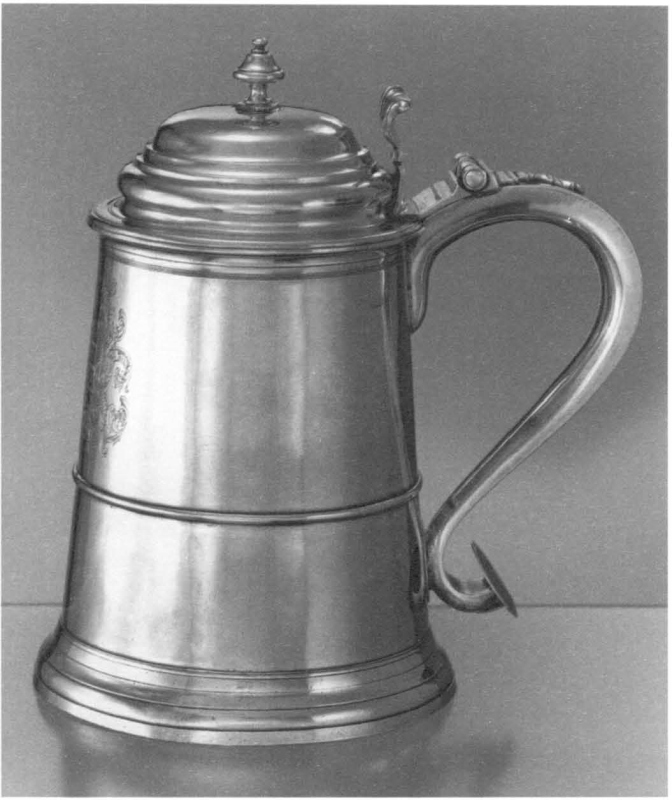
Fig. 10. John Burt (1693–1746), tankard, Boston, Massachusetts, ca. 1745. Silver; h. 8¼ in. Yale University Art Gallery, Mabel Brady Garvan Collection (1930.1195).
Jeremiah Moulton of York received a handsome tankard (fig. 10), presented, according to family tradition, by William Pepperrell. Moulton, who had been captured by Indians as a child, later gained substantial military experience during the English-Native warfare of the 1720s. In the 1745 siege, he distinguished himself in his command of Maine’s third regiment. The tankard bears an engraving of the Moulton arms on the front; on a circular handle terminal appears a map with “Lewisburg” above and “Taken by the English / July 17, 1745,” below.63
Another Louisbourg officer, Colonel Joseph Frye (later major general) also received a tankard for his military service, though his vessel commemorated an event later in his career. Born into a prominent family in Andover, Massachusetts, Frye grew up to pursue an active political and military career. In 1755 Colonel Frye went to Nova Scotia as part of the British and colonial force that deported and dispersed many of the Acadians living in the region.64 Late in the spring of the following year, his fellow officers from the battalion presented him with a handsome tankard. The piece bore his coat of arms on the front, his ciphered initials on the handle terminations, and a detailed inscription:
To Joseph Frye, Edq. / Colonel and Commander-in-Chief of / the forces in the services of the / Province of Massachusetts Bay / And late Major of the Second Battalion of General / Shirley’s Provincial / Regiment./ This Tankard / From a just sense of his care and conduct / of the Troops while under his command / at Nova Scotia and a proper appreciation of his Paternal Regard / for them since their return / to New England is / presented by / His Most Humble Servants / The Officers of Said Battalion./ Boston, Apr. 20d, 1757.65
Reflected in the tankard was a great respect and appreciation for Frye’s leadership, service, and prestige, attributes that after further military service in the colonial wars won him a substantial land grant in 1761. The tract of land, in western Maine, became Frye’s home in 1771, attracted several more families, and ultimately grew into present-day Fryeburg.
The first known piece of Maine presentation silver honored entrepreneurial rather than military aptitude. A medal struck in 1687 commemorated the achievement of William Phips, one of colonial Maine’s most successful inhabitants, who retrieved a substantial treasure from a sunken ship.66 Born in Woolwich, Maine, Phips became a shipbuilder and merchant, operating in Maine until the Indian Wars drove him to Boston. In 1683 Phips embarked on an audacious scheme: he determined to retrieve the cargo from a Spanish treasure ship that had gone down in shallow waters off the island of Hispaniola in the West Indies forty-four years earlier. Phips’s initial effort—backed by King Charles II—ended without the expected retrieval, but he did manage to bring up some silver. His efforts proved more successful on the second try, funded by Christopher, duke of Albermarle, and some friends when King James II proved unwilling to follow his predecessor’s example. Diving in forty-three to forty-eight feet of water with equipment largely designed by Phips, the sailors secured £300,000 sterling worth of silver, gold, and jewelry—an enormous haul!
Phips traveled to London to receive the accolades of his grateful backers, and he was an instant sensation. The duke gave Phips a golden cup and the king, who got a share of the booty despite his unwillingness to invest, knighted Phips, had a medal struck in his honor, and made him High Sheriff of New England. Soon after, Phips was appointed Royal Governor of Massachusetts. Unlike the unique pieces described above, the Phips medal, made from dies by Englishman George Bower, was produced in a number of copies in both gold and silver. According to one source, the king presented medals to the ship’s officers, to each of the promoters, and occasionally to his friends and favorites. Most likely, Phips would have done the same. The medal (fig. 11) carried on its face the portraits of James II and his wife with the motto “IACOBVS·II·ET·MARIA·D·G·MAG·BRI·FRAN·ET·HIB·REX·ET·REGINA” (James II and Mary, by the grace of God, King and Queen of Great Britain, France and Ireland). The treasure hunter was rendered on the reverse: a ship, at a distance, with a boat in the foreground over a wreck. Above the image appeared the phrase “SEMPER TIBI PENDEAT HAMUS” (Let thy hook always hang [i.e., persevere]), and below, “NAVFRAGA REPERTA / 1687” (Shipwreck recovered / 1687).67
Fig. 11. George Bower (d. 1690), medal, London, 1687. Silver; diam. 2⅛ in. Maine State Museum (96.75.1).
The small size of the medals distinguished them categorically from the later presentation pieces, which were large enough to display on top of a cupboard or on a shelf. Judging from the wear on the medal at the Maine State Museum, it seems likely that its owner carried it with him to show as a symbol of an exceptional relation to Phips or even to the king. For Phips, of course, this direct expression of the king’s favor must have proven highly useful as he strove for political and social betterment.
◑
For a demonstration of social status and power, nothing could compete with such presentation pieces, which were by definition very limited in distribution. Nonetheless, Maine’s leading citizens could express their importance with a variety of smaller silver objects, still limited to those with privilege but much easier to acquire. Personal luxuries, such as seals and seal rings, and social luxuries, such as fine tea sets, could serve the purpose well. The region’s elite also indulged in a diminutive form of “presentation,” typically presenting one another with small commemorative objects to mark familiar rites of passage.
Those individuals with the privileges of good education and solid wealth could own personal seals and seal rings, often of gold and at times of silver or brass, which they used to impress wax seals on documents. Of the few extant Maine-related seals, the earliest is a gold ring plowed up in 1855, with gold and silver coins, on Richmond Island. It has an elaborately engraved bezel with the initials “CV” centered over a lovers’ knot, and inside the band appears the motto “United [conjoined hearts] death only parts.” Two seals, one brass and silver, came out of an excavation at early Pemaquid. The silver piece, the more elaborate of the two, has a molded post bored at the top for a string or cord (fig. 12). The initials “DH” over a heart, enhanced by delicate foliate engraving, appear on the face. This seal may have belonged to Dennis Hegeman, a prominent Pemaquid citizen, who was captured by the Indians in 1689 and was still living in Canada in 1693.68 Among the seals recorded in probate records (six silver items and two gold), one stands out because of the efforts made by the family to pass it through a line of first-born sons. In the will he wrote on January 7, 1690/1, Charles Frost, Sr., bequeathed “My gold seal ring” to his oldest son, Charles. In turn, on September 24, 1724, Charles Frost, Jr., willed “Unto my Eldest Son Charles Frost . . . my Seal ring.” The ring still resides in family hands.69
Beginning early in the eighteenth century, some gentlemen had the opportunity to demonstrate their status and power with a most select article, the silver-hilted word, which symbolized the leadership, wealth, and gentility of their possessors. The men who owned them usually carried military tides as well, ranging from captain to colonel, and they also usually had substantial holdings of silver. For example, William Whipple of Kittery owned overall 117 ounces of silver; Thomas Perkins of Arundel owned a distant but still impressive 42 ounces. In general, the list of the owners’ surnames—Pepperrell, Frost, Hammond, Gerrish, Whipple, Lithgow—reads like a “Who’s Who” for early Maine.70
The small, relatively poor population of the seventeenth century and the region’s limited military preparedness probably explains the rarity of such swords during the early years. Finally, in the eighteenth century after the most devastating wars had passed, Maine gradually recovered and even began to experience some growth and prosperity. Local militia forces were reestablished and upgraded and new military leaders emphasized their stations with fine silver-hilted swords. Major Charles Frost owned the earliest silver-mounted Maine swords on record. These appear in his 1724 will as “my best Plate Hilted Sword, . . . my other Plated hilted Sword, . . . and my Silver Hilted Seymater.” Then records are silent about such swords until the 1750s, at which point eight turn up: four from Kittery, three from Berwick, and one from Arundel.71 Two swords, still extant, testify to the period in between. Sir William Pepperrell wore one (fig. 13) at the siege of Louisbourg.72 Another descended through the Lithgow family. Stamped twice on the handguard with “AT,” the piece has been attributed to the Boston silversmith Andrew Tyler (1692/93–1741). However, it is also marked “1701” thereby casting doubt on the attribution. The name “CAPT WM. LITHGOW”, engraved on one side of the counterguard, identifies the owner as the William Lithgow who served as commander of St. Georges Fort (Thomaston, Maine) in the 1730s and later at one of several Kennebec River forts.73
Somewhere between the presentation items, which bespoke the recipient’s importance so broadly, and the more democratic domestic pieces, such as silver spoons, are the larger and much more elaborate silver objects that served as social ritual centerpieces in well-to-do homes. The tea set epitomized this role in the daily lives of Maine’s middle and upper classes. The expense of the tea, the costly equipage, and the leisure time needed to enjoy the tea ritual and to learn the associated etiquette eliminated the less affluent from participation. In the genteel families that could afford it, the tea ceremony served to cement family ties and maintain social networks, with regular reinforcement through frequent reciprocal visits. From such gatherings evolved advantageous marriages, profitable business deals, and useful political agreements. Furthermore, for the participants, they were a lot of fun.74
Probably due to Maine’s long years of military conflicts, tea drinking reached the region a bit late. Probate records dated as late as the mid-1730s reveal no tea related articles. Over the next decade and a half, though, tea consumption became well established.75 Teaspoons, often in sets of six and probably intended for entertaining, appeared in nineteen Maine inventories; frequently, the same list included other tea paraphernalia. For example, Thomas Perkins, Tr.’s 1756 inventory noted “1 Tea Pot [probably ceramic] & 1/2 Doz. Tea Spoons & Tongs . . . [and] 1/2 Doz. Tea Cups . . . & 1/2 Doz. Large Silver Spoons.” This collection pales in comparison to the 1750 holdings of Josiah Cocks, late of Falmouth, which included “1 Dutch Tea Table . . . , 1 Mahogany Tea Chest with Canisters . . . , 1 Brass Ditto with Ditto . . . , 3 large Silver Spoons, 4 Tea Do . . . , Cheny [China] war . . . , 1 Block Tin Teapot . . . , 1 Tea Kettle . . . [and] 1 Coffee pot.” The tea service ritual had reached colonial Maine.76
Fig. 13. Unknown maker, sword with silver hilt and scabbard, ca. 1720–25. Silver, steel, leather, wood; 1. 38½ in. Massachusetts Historical Society, Gift of Usher Parsons (0308.01–02).
Despite this obvious surge in the desirability of tea accoutrements, few Maine-related silver hollowware pieces previous to 1765 seem to have survived. Only one reference, to an ambiguous tea “strainer,” appears anywhere in the inventories, and only one extant piece, Sir William Pepperrell’s silver teapot by Jacob Hurd, ca. 1735–1745, precedes the 1760s.77 Until that time, according to the evidence, few people in the region could afford silver tea service pieces; most probably settled for more humble wares, as did the two individuals who owned teapots of “block tin,” one of the base metal substitutes for silver.78 The sudden rise in hollowware pieces in 1760s included a silver creamer and a pair of sugar tongs, made by Paul Revere in 1762 for Stephen and Deborah (Ellis) Smith of Machias; a teapot by Benjamin Burt, signed S / P*E / 1765, for Peter and Elizabeth (Wendell) Smith of Falmouth; and a service with a teapot and creamer by Nathaniel Hurd and a sugar bowl by his father Jacob, all with the Howard family coat of arms. The creamer dates from 1766, the year that Samuel Howard of Fort Western (present-day Augusta) married Sarah Lithgow.79
◑
Major acquisitions of silver pieces, both domestic and display, often coincided with major family events. Birth, love, marriage, and death were all observed with gifts of silver, which also served to integrate the recipient into the social network of major families. In his 1724 will, for example, Major Charles Frost made gifts to each of his daughters that clearly linked the young women to their prestigious birth family: he bequeathed each daughter a silver porringer, which he probably acquired soon after each birth, “marked with her Name” if unmarried or “with her Maiden Name” if married. Two other items listed in early-eighteenth-century estate inventories, “a childs whyrl” and an “old whisel piece,” were probably gifts for new infants.80
Marriage, an event that illustrates most explicitly the web of societal connections among families, frequently merited gifts of silver. Wedding bands, certainly the most visible emblems of one’s wedded status, undoubtedly comprised a fair number of the nearly seventy rings, invariably gold, located in pre-1760 Maine probate records.81 One anonymous testament to love, a seventeenth-century silver thimble (see fig. 8) excavated at Pemaquid, displays two entwined hearts bearing the initials “S H” flanked by two cupids.82 Later pieces, ranging from spoons to tea services, often had a triangular set of initials with that of the surname surmounting those of each partner’s given name. Examples of this sort include a pair of canns marked “W / WM” for William and Man’ (Cutts) Whipple of Kitten?, apparently acquired about the time of their marriage in 1762, and two tankards with “S / I*S” engraved on the handle for Jonathan and Sarah Sayward of York, married in 1760.83 Families would often use silver to honor a marriage some years after the wedding ceremony. For example, a teaspoon marked “S / M*M / 1764” belonged to Moses and Miriam (Stone) Sewell of York, who were married seven years earlier, and a pair of sugar tongs marked “F / E*M” for Enoch and Mary (Wright) Freeman of Portland were probably acquired some time after their marriage in 1742.84
The tradition of the mourning ring, once as well known as the wedding band, typically graced the funeral rites of Maine’s leading citizens. Unlike those of lesser inhabitants, the funerals of the region’s elite involved a level of solemn ostentation appropriate to their rank. At the funeral, select individuals often received gold mourning rings, which provided a comforting link to departed and reminded the recipients of their own mortality and the promise of eternity.85 One 1768 example by Nathaniel Hurd, memorializing the demise of Falmouth merchant Alexander Ross, features a skull and wings on an otherwise plain gold band.86 Sir William Pepperrell fulfilled the expectations of his position when he provided mourning rings for the 1751 funeral of his son Andrew Pepperrell. On the other hand, Dorcus Cutts of York, declaring herself “sensible of ye Vanity of Splendid & pompous Funerals,” willed that no rings should be given at her funeral, which took place in 1758; she further bequeathed anything left in the estate to the poor.87
Mourning rings in particular also reified the bond between the elite and the ministry of a region. Although often less affluent than their well-to-do parishioners, due to their station the local clergy were part of the elite circle and, like their secular friends, often had holdings of silver.88 Ministers frequently received rings—the 1733 will of Nathan Lord of Berwick bequeathed “to my Minister a Gold Ring to Remembr me after my Decease”—and had rings distributed at their funerals. For instance, when Rev. Jeremiah Wise of Berwick died in January 1756, “the freeholders and other inhabitants of the First Parish of Berwick” ordered “all things necessary to the funeral” including “six rings for the bearers, [and] gloves for the bearers and their wives.” These rings, one of which still exists, bore the skull and wings and the inscription “Revd. Mr. J. Wise OC / 22 Jan 1756 A 76.”89
◑
Domestic silver displays and presentation pieces, both familial and broadly political, demonstrated the owner’s prestige and power at that moment in time. Many citizens with the necessary wealth also sought to establish personal and family legacies via silver, which they achieved both through simple inheritance and through the grand gesture of bequests of silver wares to the community church.
Given the importance of the acquisition of silver and gold items among colonial gentry, it is not surprising that each family would also put a great deal of effort into the details of generational descent. The wills of the two Pepperrell patriarchs, which demonstrate the usual patterns of bequest albeit in a particularly exaggerated form, also show the association between the distribution of the family silver and the preservation of the family name. In his 1733 will, Colonel William Pepperrell left all his plate to his wife but instructed that upon her death one half would go to son William (the future baronet) and the other half would be divided among five daughters and the children of a sixth who had died. In 1759, Sir William, who had no direct male heir, willed that his daughter’s son William Pepperrell Sparhawk could, upon legally dropping his surname, inherit the title and, among other things, “all my Set of Plate which I received of Sir Peter Warren,” all family paintings, and the first Sir William’s sword and gold watch. Even that, however, by no means depleted the silver holding of Sir William, for when his widow May died in 1790, she left in “old & new Silver plate” over 340 ounces valued at £102.5.5.90
Inheritance patterns also mirrored the dual economic structure, in which men participated in specific occupations such as yeoman, merchant, artisan, or mariner, and women provided the domestic support structure—which included food, clothing, and childcare—and in large part fulfilled major social roles. According to the patterns in probate records, male heirs received land and tools and women received the personal goods that enabled their domestic roles.91 Berwick widow Mary Hill, for example, willed her daughter May Leighton “one silver Salver along with wearing apparel and household goods” and at the same time saw to it that the real estate would go to her son. Mary Wise, widow of Berwick minister Jeremiah Wise, divided her substantial silver holdings, including a “Salt Seller,” a cann, and two porringers, among her two daughters and three granddaughters. Among the specific objects handed down the male line were silver-hilted swords, objects that Captain Moses Butler of Berwick and Captain William Whipple of Kittery directed specifically to sons.92
Major Charles Frost’s 1724 will exemplifies the patterns noted above. Although all but one child received his or her individual piece of silver, the daughters were to divide “all the plate of his first wife,” except specific pieces given to the sons—and given according to a very clear hierarchy. Charles, the eldest son, received a silver-headed leading staff, the “best plate handled sword, a silver tobacco box,” the “best” plate hatband, a seal ring, and a porringer. The next son, John, was to have the second silver-hilted sword, the “other” plate hatband, and a porringer. Third son, Simon, was in line for a watch, a silver seal, a silver-hilted “seymater” and two silver spoons. Finally, youngest son Eliot inherited all his father’s “money in Silver and Gold,” all his father’s gold rings (excepting the seal ring), and a steel-hilted sword.93
While inheritance patterns maintained or attempted to maintain wealth within a family, which could then of course contribute to a continued status in the community, gifts of plate to the church, where they were used for the sacred communion ritual, made a much more direct statement. As expressed by Gerald Ward, “one of [the donors’] . . . reasons for giving pieces of suitably engraved, durable silver was to demonstrate their exalted role in the social hierarchy through their benevolence to grateful, yet suitably subservient congregations.” Generations of parishioners, using the same pieces, would remember the family’s generosity and status.94
The two major groups of pre-1760 church silver in Maine, one belonging to the South Berwick First Congregational Church and the other to the First Congregational Church of Kittery, include significant representations of two of the region’s most powerful families. The South Berwick church has six early pieces, at least two of which came directly from the Frost family. Major Charles Frost bequeathed a small English tankard in 1724. A simple piece with a plain cylindrical body and molded lip and base, it stands five and a quarter inches high and sports a flat-topped cover with pointed front, a double cupped thumbpiece, and a large scrolled handle. It has a London date-letter for 1674–75 and a “WC” maker’s mark.95 The major’s sister, Mary Hill, also gave the church a beaker. Three unrelated members of the local elite donated the remaining pieces, four beakers and a basin. Elder Nathan Lord, a well-to-do yeoman, left a £20 bequest with which the church purchased two of the beakers. In 1703, Ichabod Plaisted, a merchant and militia colonel, gave “Two silver Cupps, a Table cloth & Napkins . . . to the Chh. To furnish the Communion Table.” The “Crisening basin,” given in 1763, came from Elder Humphrey Chadebourne, a wealthy Berwick gentleman.96
The Pepperrell family appears to be responsible for nearly all of the seven early pieces, dating from 1733 to about 1765, at the First Congregational Church of Kittery. Three are cups acquired with funds from the bequest of William Pepperrell, Sr.; his daughter Jane Turell left money for a fourth cup, similar in style, that the church acquired in about 1765. Sir William Pepperrell, the elder Pepperrell’s son, left funds that were used for the purchase of a baptismal basin. A large, two-handled cup, with the inscription “This piece of / plate is presented to the / first Church in / Kittery by an / Unknown / Hand,” is attributed in local tradition to Lady Mary Pepperrell, wife of Sir William. Identified as a “sprinkling font” by one author, it may have been a companion piece with the baptismal basin provided by her husband.97
The final piece, a two-handled cup, duplicated the first three Pepperrell cups. William Whipple, a relative newcomer to the region—he arrived from Ipswich in 1722—gave the cup in 1728 as an outright gift rather than a bequest. This donation, along with several other factors, suggests that Whipple wanted to establish his position among the local gentry. His elegantly furnished home included a fine cupboard of plate that consisted of a tankard, one small and four large porringers, a spout cup, two cans, twelve large spoons, eleven teaspoons, tongs, a pepper box, a mustard pot, and a strainer. He also owned a silver-hilted sword and carried about a fine silver watch.98
Extant pieces from churches in York and Falmouth (now Portland) probably came from a series of new acquisitions that took place as towns expanded in the late colonial and post-Revolutionary periods. In many cases, the growth prompted communities to found new churches and to upgrade the wares of their older churches. During this time, the First Congregational Church of York acquired a number of pieces (fig. 14) from the bequests of Alexander Maxwell and Deacon Jeremiah Bragdon. An ambitious farmer, Maxwell instructed in his will that, after his wife’s demise, half of his land and marsh should go to Rev. Samuel Moody and half to the church. Using these funds, the church had four matching tankards made in 1760 and a set of six beakers in 1785; Boston smith Daniel Parker filled both commissions. Parker also made a two-handled cup bought with Bragdon’s bequest in 1767.99 The Falmouth pieces, from the First Parish Church, include two tankards and a cann. The tankards, dating ca. 1760–1770 and made by Daniel Boyer of Boston (1725–1779), are simply inscribed “The first / Church of Christ / IN / FALMOUTH.” The pint cann was a gift to Rev. Samuel Deane from twenty-one young men in the parish.100
Fig. 14. Daniel Parker (1726–1785), silverwares, Boston, Massachusetts, 1760–1785. Silver; h. (tankards) 9 in. Old York Historical Society.
Looking at all of these collections chronologically, one can trace subtle shifts in the conventions that shaped the relationship between the town church and the town elite. The South Berwick holdings, which represent the earliest period and came mostly through direct donations or bequests from unrelated individuals, show the most variation in style. The Kittery church, from a slightly later period overall, purchased its silver using monetary bequests. The consistency among the five smaller cups and the one large one reflects a stylistic lineage.101 An evolution in inscriptions suggests an increasing proclivity to use church silver in the definition of status. South Berwick’s 1703 beakers carried the simple inscription “‘X. dono I / a / c Plaisted / 1702.’” The engraving on the Frost tankard donated two decades later read “Ex Dono / Charles Frost / to the Church / of Berwick.” In 1734, the Kittery church acquired three of its two-handled cups as “The Gift of Honble Wm. Pepperell Esqr / to the First Church of Christ In Kittery / 1733.” He was thoroughly outdone by the baptismal basin from his son, which had the family arms on the rim and a very detailed inscription: “The Gift of the Honble. Sir WILLIAM PEPPERRELL Baronet, Lieut. General of His Majesty’s Forces, & of the Province of the Massachusetts &c. &c. to the First Church in KITTERY.”102
The shimmer of precious metals probably was a major presence in the lives of a limited number of early Maine inhabitants. However, the effect of these items extended far into the local communities and across the region as a whole. The major role of silver (and gold) was highly conservative—maintaining the societal structure. Early on, it symbolized and verified the power and status of the “Great Families” and later signaled the wealth and enhanced stature of the rising merchant class. A powerful emblem of marriage and family, it was also part of social networking epitomized in the colonial tea ritual. A comfort in its actual metallic value per se, it could, in currency form, serve a role in keeping all in their proper places and seriously chastising those who deviated. Many of the society’s patterns would still have been similar without the presence of silver and gold; however, there is little doubt that precious metals strengthened extant cultural structures. Without these wares, early Maine would not have been quite the same.
Notes
1 Henry N. Flynt and Martha Gandy Fales, The Heritage Foundation Collection of Silver, with Biographical Sketches of New England Silversmiths, 1625–1825 (Old Deerfield, Mass.: Heritage Foundation, 1968), 174, 267.
2 Edwin A. Churchill, “Mid-Seventeenth Century Maine: A World on the Edge,” in American Beginnings: Exploration, Culture and Cartography in the Land of Norumbega, ed. Emerson W. Baker, Edwin A. Churchill, Richard S. D’Abate, Kristine L. Jones, Victor A. Konrad, and Harold E. L. Prins (Lincoln: University of Nebraska Press, 1994), 240–41; William Hubbard, The History of the Indian Wars in New England, 2 vols., ed. Samuel G. Drake (Roxbury, Mass.: W. Elliot Woodward, 1865), 2:76; Samuel Maverick, “A Brief Description of New England and the Several Towns Therein, Together with the Present Government Thereof” Proceedings of the Massachusetts Historical Society, 2d ser., 1 (1884–1885): 231–32.
3 Churchill, “Mid-Seventeenth Century Maine,” 251–57; Edwin A. Churchill, “Too Great the Challenge: The Birth and Death of Falmouth, Maine, 1624–1676” (Ph.D. diss., University of Maine, 1979), 273–78.
4 York Deeds, 18 vols., various eds. (Portland: [Vols. 1–9], and Bethel: [Vols. 10–18]: various publishers, 1887–1910) (hereafter cited as YD) 5 (1): 29.
5 Charles T. Libby, Robert E. Moody, and Neal W. Allen, eds., Provincial and Court Records of Maine, 1636–1727, 6 vols. (Portland: Maine Historical Society, 1928–1975) (hereafter cited as PCRM), 2: 292–95; YD, 5 (1): 6.
6 PCRM, 2: 380–83; YD, 5 (1): 56.
7 York County Registry of Probate, vols. 1–20 (hereafter cited as YCRP), 8:209–11.
8 In order to understand any piece of silver, extant or otherwise, as it functioned in Maine during this period, it is vital to keep in mind the effects of war on the general development of the region and on the available sources for research today. The availability of inventories in state records clearly reflect the impact of the warfare. The town of Kittery, the furthest from the fighting, had the highest rate of silver ownership in the state, and the estates of Kitten’ inhabitants were the most frequently recorded in Maine files. To the east, the situation deteriorated rapidly. Although the communities of Berwick, Wells, and York managed to survive the wars, their populations dropped; correspondingly, so did the number of inventories. East of Wells, the region was essentially deserted, except for a couple of brief periods, until the 1730s and 1740s; not surprisingly, there were few inventories from the region during the war years.
9 Grahame Clark, Symbols of Excellence (Cambridge: Cambridge University Press, 1986), 93; Churchill, “Too Great the Challenge,” 138–39, 410–20.
10 PCRM, vol. 1–2; YD; YCRP.
11 This and the next paragraph were developed from an analysis of 160 Maine estates dating from 1648 to 1760 with listed silver and gold items.
12 YCRP, 8:209–11.
13 YCRP, 9:4–5.
14 YCRP, 8:209–11. For other examples see YD, 5 (1):16–17, and YCRP, 9:154.
15 YCRP, 9:86–87, 146–47. See also YCRP, 8:137–39, 176–77.
16 Gerald W. R. Ward, “‘An Handsome Cupboard of Plate’: The Role of Silver in American Life,” in Silver in American Life: Selections from the Mabel Brady Garvan and Other Collections at Yak University, ed. Barbara McLean Ward and Gerald W. R. Ward (New York: American Federation of Arts, 1979), 33.
17 Communication with Robert B. Barker, April 18, 1996.
18 Coins appeared with relative frequency in Maine court and probate records and are continually coming to light in archaeological excavations in the region. It is important to note that there were two very distinct types of coins—those of precious metals (gold and silver) and those of base materials (most often copper). The base metal coins, by and large, served for local exchange, the stuff of normal day-to-day transactions. Yet, even though they were a vital component in daily life, they were viewed not as real money but as a convenient substitute. Philip L. Mossman, Money of the American Colonies and Confederation: A Numismatic, Economic and Historical Correlation (New York: American Numismatic Society, 1993), 112–13.
19 PCRM, 1:276.
20 Mossman, Money of the American Colonies, 30–32, 36–37.
21 YCRP, 1:45, 81; 3:186, 257; 9:218–19; Mossman, Money of the American Colonies, 52, 64–72.
22 Mark Girouard, “The Power House,” in The Treasure Houses of Britain: Five Hundred Years of Private Patronage and Art Collecting, ed. Gervase Jackson-Stops (Washington D.C. and New Haven, Conn.: National Gallery of Art and Yale University Press, 1985), 22; Churchill, “Mid-Seventeenth Century Maine,” 249–50; David Grayson Allen, “Vacuum Domicilium: The Social and Cultural Landscape of Seventeenth-Century New England,” in New England Begins: The Seventeenth Century, ed. Jonathan L. Fairbanks and Robert F. Trent, 3 vols. (Boston: Museum of Fine Arts, Boston, 1982), 1:1–2, 49.
23 “Early Maine leadership—demographic and economic profiles,” Maine Silver Files, Maine State Museum (hereafter MSM). A major source of information on this topic is Sybil Noyes, Charles T. Libby, and Walter G. Davis, Genealogical Dictionary of Maine and New Hampshire (Baltimore: Genealogical Publishing Co., 1972) (hereafter cited as NLD).
24 “Early Maine Leadership,” Maine Silver Files, MSM. Major sources of information on Maine’s sawmills and millers include Richard Candee, “Merchant and Millwright: The Water Powered Sawmills of Piscataqua,” Old-Time New England 40 (Spring 1970): 131–49, and TD. vols. 1–5, along with selected references in YCRP, vols. 1–10, and PCRM, vols. 1 and 2.
25 Richard M. Candee, “The Architecture of Maine’s Settlements: Vernacular Architecture to About 1720,” in Maine Forms of American Architecture, ed. Deborah Thompson (Camden, Me.: Downeast Magazine, 1976), 37; Richard M. Candee, “Wooden Buildings in Early Maine and New Hampshire: A Technological and Cultural History, 1600–1720” (Ph.D. diss., University of Pennsylvania, 1976), chapter 2. Examples of finely furnished best spaces include the Kitten’ estates of Captain John Mitchell (1664), William Leighton (1667), and Robert Cutts (1674), and the York estate of Major John Davis (1691). PCRM, 1:227–29, 301–4; 2:292–94; TD, 5 (1):65.
26 Candee, “The Architecture of Maine Settlement,” 38.
27 TD, 5 (1): 15–17.
28 TD, 5 (1):15–17.
29 NLD, 540–41.
30 Personal communication with Joseph W. P. Frost, March 29, 1996.
31 Kathryn C. Buhler and Graham Hood, American Silver: Garvan and Other Collections in the Tale University Art Gallery, 2 vols. (New Haven: Yale University Press for the Yale University Art Gallery, 1970), 1:121–22.
32 Communication with Michael K. Brown, May 3, 1985. The caster is part of the Bayou Bend Collection, the Museum of Fine Arts, Houston. Buhler and Hood, American Silver, 1:59, 61, illustrates a caster by Tyler similar to that held at Bayou Bend.
33 NLD, 487; YCRP, 4:49.
34 William Willis, The History of Portland, from 1632 to 1864, 2d ed. (Portland, Me.: Bailey and Noyes, 1865), 824–26; YCRP, 8:130–32.
35 Some extant family objects not covered in the body of the paper are still worth recording. A piece of Frost family silver still extant is known only from a photograph. A mid-eighteenth-century baluster-shaped cann, according to a note on the back, was apparently “purchased by some movie actor or actress from Hollywood for their collection” (photo of Frost cann, privately held). A modest number of other documented major pieces have been identified. For example, a pair of tankards were made about 1760 by Boston silversmith Benjamin Burt for York merchant Jonathan Sayward and his wife Sarah (Mitchell) (no. 1958.001, tankard, Old York Historical Society-Collections Database Report; Penny J. Sander, Elegant Embellishments: Furnishings from New England Homes, 1660–1860 [Boston: Society for the Preservation of New England Antiquities, 1982], 35; Richard C. Nylander, “The Jonathan Sayward House, York, Maine,” Antiques 116, no. 4 [September 1979]: 567–77; NLD, 610–11). Also, two keyhole-handled porringers, dating from about the same period, were the property of Maine’s early elite. One created by Stephen Emery of Boston, was made for Thomas and Elizabeth Cutts of Saco. The other descended through the Freeman family of Falmouth. Quite likely created for Enoch Freeman, it apparently passed to his son Samuel and then Samuel’s daughter Dorcus (Freeman) Homes (American Silver Collected by Philip H. Hammersbugh [Hartford, Conn.: privately printed, 1965], 3:41; NLD, 177–79; no. 1841, porringer, Maine Historical Society Curatorial Files; Willis, Portland, 746–47, 805–7).
36 Ward, “Handsome Cupboard of Plate,” 33, 102–3.
37 YCRP, 1:18, 79; 2:1–2, 27–29; 3:147–49.
38 Martha Gandy Fales, Early American Silver for the Cautious Collector (New York: Funk & Wagnells, 1970), 238–40.
39 Buhler and Hood, American Silver, 1:121–22; John Eldridge Frost, The Nicholas Frost Family (Milford, N.H.: The Cabinet Press, 1943), frontispiece, 1, 15; photo of Frost cann, privately held; Ian M.G. Quimby, American Silver at Winterthur (Winterthur: Henry Francis du Pont Winterthur Museum, 1995), 133–34.
40 The significance of personal objects is clearly reflected in the 1724 will of Major Charles Frost, YCRP, 3:145–47. Even with small objects, only a minority of the inhabitants owned silver and gold objects, and despite some exceptions, most owners were of the upper-middle and upper classes. “Probate Records, 1648–1760,” Maine Silver Files, MSM; Churchill, “Mid-Seventeenth Century Maine,” 241; James S. Leamon, Revolution Downeast: The War for American Independence in Maine (Amherst: University of Massachusetts Press, 1993), 6. Barbara McLean Ward makes the same point for New England in “Metalwares” in The Great River: Art and Society of the Connecticut Valley, 1635–1820, ed. Gerald W. R. Ward and William N. Hosley, Jr. (Hartford, Conn.: Wadsworth Atheneum, 1985), 274.
41 “Forms of Silver—Early Maine,” Silver Files, MSM.
42 “Forms of Silver—Early Maine,” Silver Files, MSM.
43 PCRM, 1:227–29; YD, 5 (1):13; YCRP, 9:261–62; 10:16.
44 Pemaquid spoons: Robert L. Bradley and Helen B. Camp, The Forts of Pemaquid, Maine: An Archaeological and Historical Study (Augusta: Maine Historic Preservation Commission, The Maine Archaeological Society, and the Maine Bureau of Parks and Lands, 1994), 184–85, 187. The Defence spoons, part of the Defence collections, are at the MSM. Excepting one with raised cast letters, all had initials engraved or scratched into the back of the handles.
45 “Forms of Silver—Early Maine,” Silver Files, MSM.
46 YD, 5 (1):9; YCRP, 4:75; 8:57, 140–41.
47 Helen B. Camp, Archaeological Excavation at Pemaquid, Maine, 1965–1974. (Augusta: Maine State Museum, 1975), 44–45; Emerson W. Baker, The Clark and Lake Company: The Historical Archaeology of a Seventeenth-Century Maine Settlement (Augusta: Maine Historical Preservation Commission, 1985), 21.
48 “Forms of Silver—Early Maine,” Silver Files, MSM.
49 Nathaniel Shurtleff, ed., Records of the Governor and Company of the Massachusetts Bay (Boston: William White, 1854), 3:243.
50 “Forms of Silver—Early Maine,” Silver Files, MSM.
51 YCRP, 8:140–41, 160–61.
52 Camp, Pemaquid, 44–45. The “close plating” process is described in Frederick Bradbury, History of Old Sheffield Plate (London: Macmillan and Co., 1912), 5–6, and Diana Cramer, “Philadelphia Silverplaters, 1778 to 1840: Part II, The Methods and Hints at the Answer,” Silver 23, no. 4 (July–August 1990): 19.
53 “Forms of Silver—Early Maine,” Silver Files, MSM; PCRM, 2: 295–97; YD, 5 (1):33; YCRP, 8:244–45.
54 YCRP, 4:49; 8:48–9; Camp, Pemaquid, 48.
55 “Forms of Silver—Early Maine,” Silver Files, MSM. See also YCRP, 2:27–29; 8:130–32.
56 YCRP, 8: 130–32, 140–41, 236; 9: 133; 10: 130; Martha Gandy Fales, Jewelry in America, 1600–1900 (Woodbridge, Eng.: Antique Collectors’ Club, 1995), 58. One inventory listed an amber necklace and a second noted “20 amber beads” (YCRP, 8:118, 140–41; Fales, Jewelry in America, 21, 121–22).
57 “Forms of Silver—Early Maine,” Silver Files, MSM; Fales, in America, 58, 60. The silver clasps appeared in five inventories and the gold in three.
58 YCRP, 3:145–47, 262; 9:150–51. It is not wholly clear that the “Silver Hat lace” and “read ribbon” actually refer to silver material (e.g., silver thread) or simply some type of silvery colored element of the pieces. Only two other mentions of jewelry, one a 1678 notice of “one gould pine 28s” and the other an ambiguous listing of “Jewells,” appear in the probate records (YD, 5 [1]: 31–32; YCRP, 9:89).
59 Gerald W. R. Ward, introduction to David B. Warren, Katherines S. Howe, and Michael K. Brown, Marks of Achievement: Four Centuries of American Presentation Silver (Houston: Museum of Fine Arts, 1987), 21.
60 Extensive coverage of the Louisbourg Expedition is provided in George A. Rawlyk, Yankees at Louisbourg (Orono: University of Maine Press, 1967), and Henry S. Burrage, Maine at Louisburg (Augusta, Me.: Burleigh & Flynt, 1910). A succinct account is provided in Howard H. Peckham, The Colonial Wars, 1680–1762 (Chicago: University of Chicago Press, 1964), 97–106, and a detailed account of Pepperrell’s role is given in Bryon Fairchild, Messrs. William Pepperrell: Merchants at Piscataqua (Ithaca, N.Y: Cornell University Press, 1954), 172–77.
61 Information on the Pepperrell silver came from files at the Portland Museum of Art; Burton W. F. Trafton, Jr., “Louisbourg and the Pepperrell Silver” Antiques 89, no. 3 (March 1966): 366–68; Michael K. Brown, “The Colonial Period,” in Warren, Marks of Achievement, 29–30; communication with Joseph W. P. Frost, March 29, 1996.
62 Trafton, “Louisbourg and Pepperrell Silver,” 366; Joseph W. P. Frost, “Living with Antiques: Pepperrell Mansion, Kittery Point, Maine,” Antiques 89, no. 3 (March 1966): 368–69.
63 Buhler and Hood, American Silver, 1:100–102; NLD, 499; Charles E. Banks, History of York, Maine, 2 vols. (Boston: The Calkins Press, 1931), 1:295–97, 322–30, 332–33.
64 Allen Johnson and Duman Malone, eds., Dictionary of American Biography (New York: Charles Scribner’s Sons, 1931), 7:50–51; Peckham, Colonial Wars, 162–63; John Stuart Barrows, Fryeburg, Maine: An Historical Sketch (Fryeburg: Pequawkit Press, 1938), 28–36, 50, 170–87.
65 No. 666, tankard, Maine Historical Society curatorial files.
66 The information on Phips and his activities was found in Alice Lounsberry, Sir William Phips: Treasure Fisherman and Governor of the Massachusetts Bay Colony (New York: Charles Scribner’s Sons, 1941). The recovery of the Spanish treasure is covered in chapters 4 and 5.
67 Edward Hawkins, comp., and Augustus W. Frankes and Herbert A. Grueber, eds., Medallic Illustrations of the History of Great Britain and Ireland to the Death of George II (London: Trustees of the British Museum, 1885), 1:619; C. Wyllys Betts, William T. R. Marvin, and Lyman Haynes Low, eds., American Colonial History Illustrated by Contemporary Medals (Glendale, N.Y: Benchmark Publishing Co., 1970), 35.
68 Fales, Jewelry in America, 20; William Willis, “Remarks on Coins Found at Portland in 1849, and Richmond’s Island in 1855,” Collections of the Maine Historical Society, 1st ser., 6 (1859):143; Camp, Pemaquid, 48; NLD, 324.
69 YCRP, 1:45, 118—19; 3:145–47; 8:130–32, 140–41; personal communication with Joseph W. P. Frost, March 29, 1996; NLD, 324.
70 Same sources as footnote 45 plus NLD, 246, 257, 303, 444, 540, 543; Leola G. Bushman, “Peter Grant: Scotch Exile: Kittery and Berwick, Maine,” typescript, 1971, 37–38, Maine State Library, Augusta, Me.; Charles N. Sinnett, comp., “The Gerrish Genealogy,” typescript, ca. 1920, 4–5, Maine State Library; Everett S. Stackpole, Old Kittery and Her Families (Lewiston, Me.: Press of Lewiston Journal Company, 1903), 255–56.
71 YCRP, 3:145–47; 8:137–39, 176–77, 228; 9:39–40, 86–87, 154, 164, 200–201.
72 No. 0308.01, Massachusetts Historical Society; “Donation from Usher Parsons,” Proceedings of the Massachusetts Historical Society 1 (1862): 373.
73 Maine Antique Digest (April 1994), 11-C; Flynt and Fales, Heritage Foundation Collection, 345; James W. North, The History of Augusta from the Earliest Settlement to the Present Time (Augusta, Me.: Clapp and North, 1817), 225, 901.
74 Rodris Roth, “Tea-Drinking in Eighteenth-Century America: Its Etiquette and Equipage,” in Material Life in America, 1600–1860, ed. Robert Blair St. George (Boston: Northeastern University Press, 1988), 439–46.
75 A clear shift eastward also appears in the ownership of tea-related wares by the 1750s. Probate records only indicate two estates in Kittery with teaspoons. York, which enjoyed some commercial success during the mid-eighteenth century, had five such listings. Nearby Wells had three estates with silver tea equipage, including one with a teapot and one with “tea dishes.” In Falmouth, the rising mercantile center in the region, six estates listed silver tea wares including three teapots. “Tea Service—Early Maine,” Silver Files, MSM.
76 “Tea Service—Early Maine,” Silver Files, MSM; YCRP, 8:73–74; 9:107, 146–47.
77 Buhler and Hood, American Silver, 1:121–22; YCRP, 8:137–39.
78 “Block Tin” was a high grade pewter in which antimony replaced most or all of the lead, creating a harder, shinier surface than lead-containing pewter. When kept well polished, it served as a reasonable alternative to silver wares. See Edwin A. Churchill, Hail Britannia: Maine Pewter and Silverplate (Augusta, Me.: Maine State Museum, 1992), 59–60; “Pewter,” in E. Chambers, Cyclopaedia, Or an Universal Dictionary of Arts and Sciences, vol. 2 (London: numerous sponsors, 1738); and Malachy Postlethwayt, The Universal Dictionary of Trade and Commerce, vol. 2 (London: John and Paul Knapton, 1755).
79 Excerpts from the account books of Paul Revere provided by Michael K. Brown, December 7, 1984; Francis Hill Bigelow, Historic Silver of the Colonies and Its Makers (New York: Macmillan, 1917), 344, 410; Quimby, American Silver at Winterthur, 133–34; Antiques 138, no. 1 (July 1990): 92. The two Revere pieces and to a lesser degree the Howard example demonstrate the midcentury expansion of silver ownership eastward.
80 YCRP, 1:98–99; 2:13–14; 3:145–47.
81 Fales, Jewelry in America, 30; “Forms of Silver—Early Maine,” Silver Files, MSM.
82 Camp, Pemaquid, 44–45.
83 The New England Silversmith: An Exhibition of New England Silver from the Mid-Seventeenth Century to the Present (Providence: Museum of Art, Rhode Island School of Design, 1975), no. 68; No. 1958.001, accession files, Old York Historical Society.
84 No. 1969.003, accession files, Old York Historical Society; communication with Michael K. Brown, May 24, 1985; No. 318, Bayou Bend Curatorial Files.
85 An excellent discussion of mourning rings and other jewelry is presented in Fales, Jewelry in America, 23–28.
86 John D. Kernan, “Gold Funeral Rings,” Antiques 89, no. 4 (April 1966): 568–69; Willis, Portland, 455.
87 Fales, Jewelry in America, 25–27.
88 The estate of Reverend Shubael Dummer of York (1692), valued at £70.15.4, included a tankard, a wine cup, and a spoon (YD, 5 [1]: 72). That of Reverend John Wade of Berwick (1705), valued at £218.16s., listed a tankard and six spoons (YCRP, 1:115). The March 1, 1747/8, will of Mary, wife of Berwick pastor Reverend Jeremiah Wise, noted a salt cellar, a cann, two porringers, two gold rings, and other gold and silver (YCRP, 8:27–29).
89 Fales, Jewelry in America, 24–25; William Sargent, comp., Maine Wills, 1640–1760 (Portland: Brown, Thurston, & Co., 1887), 345; file notes, South Berwick First Parish Federated Church.
90 YCRP, 4:177–80; 10:63–69; 15:545.
91 Churchill, “Mid-Seventeenth Century Maine,” 252–55; Laurel T. Ulrich, Good Wives: Image and Reality in the Lives of Women in Northern New England, 1650–1750 (New York: Oxford University Press, 1980), 20–24, 27–32, 35–50; Barbara McLean Ward, “Women’s Property’ and Family Continuity in Eighteenth-Century Connecticut,” in Early American Probate Inventories, ed. Peter Benes (Boston: Boston University, 1989), 77–78.
92 YCRP, 8:27–29, 147, 223–24; 9:200–201.
93 YCRP, 3:145–47.
94 Ward, introduction, in Warren, Marks of Achievement, 21. Similar points are made in Barbara McLean Ward, “‘In a Feasting Posture’: Communion Vessels and Community Values in Seventeenth- and Eighteenth-Century New England,” Winterthur Portfolio 23, no. 1 (Spring 1988): 18–19.
95 E. Alfred Jones, The Old Silver of American Churches (Letchworth, Eng.: Arden Press for the National Society of the Colonial Dames of America, 1913), 451–52, plate cxxx; YCRP, 3:145–47. The tankard is presently held by the First Parish Federated Church in Berwick. It also bears the pounced date and letters “1647 / F / IE,” perhaps the initials of yet-unidentified Frost relatives.
96 Jones, Old Silver of American Churches, 451–54; “Records of the First Church of Berwick (South Berwick), Me.,” New England Historical and Genealogical Register 82 (January 1928): 74; (April 1928): 204; (July 1928): 331; Sargent, Maine Wills, 341–42; NLD, 134, 443–44, 559.
97 Jones, Old Silver of American Churches, 236–38; Stephen Decatur, “The Early Church Silver of Kittery, Maine,” American Collector (November 1936): 3, 15; NLD, 540.
98 Jones, Old Silver of American Churches, 237–38; Decatur, “Church Silver of Kittery” 3; NLD, 540; YCRP, 8:137–39; 9:86–87.
99 Jones, Old Silver of American Churches, 510; NLD, 470–71; YCRP, 7:87; 11:270–72; Banks, York, 2:78, 224.
100 Jones, Old Silver of American Churches, 377–78; Willis, Portland, 399, 650–52, 655–56.
101 Ward, “Feasting Posture,” 5. In 1828 all of the South Berwick beakers acquired matching molded bases (communication with the Reverend James Christianson, 1994).
102 Jones, Old Silver of American Churches, 236, 451–52. The elaboration of inscriptions over time and the increased emphasis on status is considered in Ward, “Feasting Posture,” 15—16. On the other hand, elements of social leveling were also present. In both churches, the drinking vessels were generally of the same form thereby eliminating the opportunity to delineate rank in terms of who got what vessel. Similarly, the practice of passing the cup from hand to hand enhanced the idea of community and equality. For further discussion on these issues, see Ward, “Feasting Posture,” 4, 12, 14, and Ward and Ward, Silver in American Life, 91.

